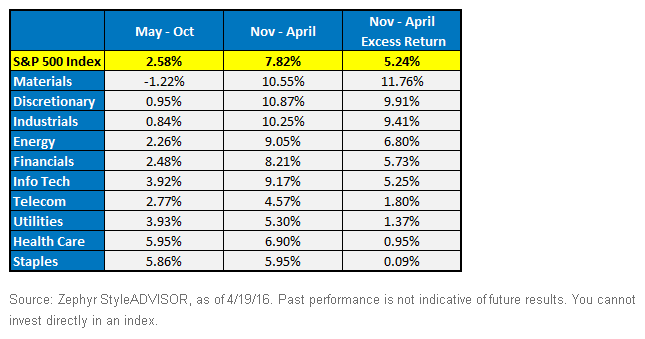Go Away in May?


 As the table above shows, a strategy that shifted from stocks to bonds in May and then rotated again into equities in November would have generated an annualized return from 1979 to 2016 of 12.98%, versus 6.56% if the investor had done the reverse and “gone away in November.” That annualized return of nearly 13% would have outpaced the S&P 500 by more than 130 basis points (bps) per year with a 30% reduction in annualized volatility. The same strategy beat an all-year-round 50/50 allocation to stocks and bonds by 288 basis points on an annualized basis.
Interestingly, from January 1, 1979, through December 31, 1999, the 17.9% annualized total return the S&P 500 Index generated was only slightly better than the 17.6% the Go Away in May strategy generated. Moreover, the Go Away in May strategy was able to generate 98% of the S&P 500’s return with just 71% of the equity market’s volatility over that period. Thereafter, that relationship changed. From January 1, 2000, through March 31, 2016, the Go Away in May strategy returned 7.27% on an annualized basis, outperforming the S&P 500 Index by 319 basis points per year, with a similar reduction in market volatility.1
Sector Returns, “Going Away in May”
What happens at the sector level when an investor goes away in May? Interestingly, the same pattern emerged. The sectors of the S&P 500 generated higher average returns in the November through April period than they did from May through October, back to 1989, the longest period for which we had comparable data. Displayed below is the average six-month cumulative return for each of the 10 sectors of the S&P 500 and the S&P 500 Index over those different six-month periods.
Average 6-Month Cumulative Total Returns, S&P 500 Index and S&P 500 Sectors, November 1, 1989 – October 31, 2015
As the table above shows, a strategy that shifted from stocks to bonds in May and then rotated again into equities in November would have generated an annualized return from 1979 to 2016 of 12.98%, versus 6.56% if the investor had done the reverse and “gone away in November.” That annualized return of nearly 13% would have outpaced the S&P 500 by more than 130 basis points (bps) per year with a 30% reduction in annualized volatility. The same strategy beat an all-year-round 50/50 allocation to stocks and bonds by 288 basis points on an annualized basis.
Interestingly, from January 1, 1979, through December 31, 1999, the 17.9% annualized total return the S&P 500 Index generated was only slightly better than the 17.6% the Go Away in May strategy generated. Moreover, the Go Away in May strategy was able to generate 98% of the S&P 500’s return with just 71% of the equity market’s volatility over that period. Thereafter, that relationship changed. From January 1, 2000, through March 31, 2016, the Go Away in May strategy returned 7.27% on an annualized basis, outperforming the S&P 500 Index by 319 basis points per year, with a similar reduction in market volatility.1
Sector Returns, “Going Away in May”
What happens at the sector level when an investor goes away in May? Interestingly, the same pattern emerged. The sectors of the S&P 500 generated higher average returns in the November through April period than they did from May through October, back to 1989, the longest period for which we had comparable data. Displayed below is the average six-month cumulative return for each of the 10 sectors of the S&P 500 and the S&P 500 Index over those different six-month periods.
Average 6-Month Cumulative Total Returns, S&P 500 Index and S&P 500 Sectors, November 1, 1989 – October 31, 2015
 Over the last quarter century, the S&P 500 Index average return from November through April has been more than 5 percentage points higher than its average return from May through October. Interestingly, the sectors that held up best on a relative basis during the May through October period were the four defensive sectors of the market: Consumer Staples, Health Care, Utilities and Telecom. It is outside the scope of this blog post to explain the reasons that may account for why U.S. stocks have underperformed from May through October. For now, let us simply digest that it has happened and that it has persisted in the current investment landscape, through two bear markets and two bull markets, with robust resiliency, back to 2000.
Conclusion
One of the most interesting aspects of “Go Away in May” is the evidence that it continues to exist, despite a vernacular awareness of its existence. Net-net: Given the market’s current heightened valuation and current dependence on the direction of oil prices, the reality that we are entering a seasonally and historically subpar period for the market should give investors an additional reason to proceed with caution in the months ahead.
1Returns specified in this paragraph are from Zephyr StyleADVISOR and Bloomberg, as of 4/6/16.
Over the last quarter century, the S&P 500 Index average return from November through April has been more than 5 percentage points higher than its average return from May through October. Interestingly, the sectors that held up best on a relative basis during the May through October period were the four defensive sectors of the market: Consumer Staples, Health Care, Utilities and Telecom. It is outside the scope of this blog post to explain the reasons that may account for why U.S. stocks have underperformed from May through October. For now, let us simply digest that it has happened and that it has persisted in the current investment landscape, through two bear markets and two bull markets, with robust resiliency, back to 2000.
Conclusion
One of the most interesting aspects of “Go Away in May” is the evidence that it continues to exist, despite a vernacular awareness of its existence. Net-net: Given the market’s current heightened valuation and current dependence on the direction of oil prices, the reality that we are entering a seasonally and historically subpar period for the market should give investors an additional reason to proceed with caution in the months ahead.
1Returns specified in this paragraph are from Zephyr StyleADVISOR and Bloomberg, as of 4/6/16. Important Risks Related to this Article
One of the most interesting aspects of “Go Away in May” is the evidence that it continues to exist, despite a vernacular awareness of its existence. Net-net: Given the market’s current heightened valuation and current dependence on the direction of oil prices, the reality that we are entering a seasonally and historically subpar period for the market should give investors an additional reason to proceed with caution in the months ahead.


